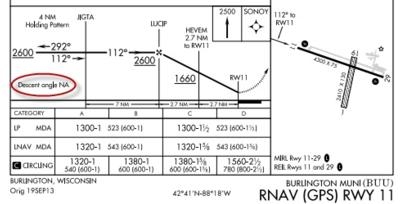Pilots Must Still Use Primary Barometric Altimeter To Comply With ATC Clearances
The FAA has published a Special Airworthiness Information Bulletin (SAIB) focusing on FMS and GPS equipment vertical guidance with no published vertical descent angle.

According to the document, the FAA says it believes advisory vertical guidance can aid the pilot when flying the final approach segment of IAPs without a glideslope or an approved glide path. As a result, there were multiple public requests for the FAA to publish vertical descent angles on these IAPs. Many manufacturers then chose to use the published vertical descent angle when providing advisory vertical guidance for these IAPs.
The types of IAPs the FAA publishes with a vertical descent angle to help provide advisory vertical guidance include: 1) conventional IAPs (i.e., very-high frequency omni-directional receiver (VOR), localizer-type directional aid (LDA), simplified directional facility (SDF), etc.); and 2) required navigation performance IAPs titled “RNAV (GPS) RWY XX” with stand-alone lateral navigation (LNAV) and/or localizer performance without vertical guidance (LP) lines of minima.
The published vertical descent angle and navigation equipment-generated advisory vertical guidance offers no guarantee of meeting altitude constraints. Advisory vertical guidance does not guarantee obstacle protection or compliance with procedural altitudes. Advisory vertical guidance solely offers an aid to help pilots establish a continuous, stabilized descent during the final approach of the IAP and avoiding the traditional “dive and drive” method. Pilots must use the primary barometric altimeter to comply with all air traffic clearances and altitude constraints.
When the FAA charts these IAPs, they do not show a vertical descent angle in the profile view. (See sample below)
The charts currently include the following statement: “Descent Angle NA”. Like flying any other IAP, the pilot must see and avoid any obstacles in the visual segment during transition to landing.
The affected IAPs may create a hazard if the pilot continued to reference the advisory vertical guidance while transitioning to the visual segment of the approach. To avoid creating a possible hazard, FAA procedure designers began excluding a vertical descent angle from these IAPs and coding a “0” (zero) in the appropriate ARINC 424 database format specifications to communicate the absence of the vertical descent angle.
Some flight management systems (FMS), multi-mode receivers (MMR), and GPS navigation equipment may experience unintended consequences if they attempt to use a “0” (zero) from the packed, onboard navigation database for the vertical descent angle. Examples of navigation equipment unintended consequences from a “0” (zero) in the packed navigation data include:
- Using the “0” (zero) and generating problematic, inaccurate vertical path guidance.
- Loading the IAP to the navigation system’s flight plan, but then failing to generate any horizontal or vertical guidance when the approach becomes active.
- Creating a “divide by zero” mathematical error preventing the navigation equipment from loading the IAP or, functioning properly when the system loads the IAP.
- Generating nuisance cockpit alerts for “low glidepath angle”.
- Assuming a “0” (zero) is invalid because the angle is too low then automatically defaulting to a three degree angle.
- “Rejecting” the affected IAPs during the database packing process and removing them from the onboard navigation database; making the IAPs unavailable from the onboard navigation database when pilots attempt to select them.

The FAA recommends operators and pilots carefully review departure, destination and alternate airport IAPs during pre-flight operations. During this review, operators and pilots should look for IAPs published with no vertical descent angle and charted with the statement: “Descent Angle NA” or “Descent Angle NA – Obstacles” in the profile view of the procedure. For these IAPs, the FAA recommends finding and planning to use another IAP (if available) not affected by this airworthiness concern.
The advise contacting the manufacturer of your navigation equipment to determine if your installed navigation equipment and operating software load is adversely affected by coding a “0” (zero) when no vertical descent angle is published:
- If the navigation equipment is not affected, no further action is necessary.
- If the manufacturer offers a new modification or other solution, the FAA recommends making the modification as soon as possible.
- If the manufacturer reports coding a “0” (zero) has unintended, negative consequences, and no current solution is available, avoid using this type of IAP.
For aircraft and navigation equipment manufacturers, the FAA recommends determining what product lines and operating software loads (if any) are affected by FAA procedure designers coding the vertical descent angle as “0” (zero). Describe to users of affected navigation equipment any immediate actions operators or pilots should take to resolve anomalous behavior. The latest revision of FAA AC 20-138, Chapter 4 contains additional airworthiness information on advisory vertical guidance through installed avionics.
(Sample chart provided by the FAA)
 ANN's Daily Aero-Linx (04.16.24)
ANN's Daily Aero-Linx (04.16.24) Aero-News: Quote of the Day (04.16.24)
Aero-News: Quote of the Day (04.16.24) Airborne 04.10.24: SnF24!, A50 Heritage Reveal, HeliCycle!, Montaer MC-01
Airborne 04.10.24: SnF24!, A50 Heritage Reveal, HeliCycle!, Montaer MC-01 Airborne 04.12.24: SnF24!, G100UL Is Here, Holy Micro, Plane Tags
Airborne 04.12.24: SnF24!, G100UL Is Here, Holy Micro, Plane Tags Airborne-Flight Training 04.17.24: Feds Need Controllers, Spirit Delay, Redbird
Airborne-Flight Training 04.17.24: Feds Need Controllers, Spirit Delay, Redbird




